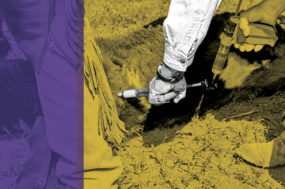When they realized a need was present for an efficient way to market cattle on the border of New Mexico and Mexico, their dream became a reality.
Operating as Santa Teresa Livestock Auction in Santa Teresa, New Mexico, they now serve customers on both sides of the border with this simple mission statement: “To serve and promote the cattle industry through fair trade, open market and transparent practices.”
The Santa Teresa Livestock Auction fills an important role for the marketing of cattle on the U.S.-Mexico border, as it is the only physical livestock auction available to customers on the border’s region in New Mexico. Although there have been other auctions in the past, there are no other operating auctions at this time. The purpose behind the Santa Teresa Livestock Auction is “to give the Mexican producer another option on marketing,” says manager William Wallace III.
Operating year-round, Santa Teresa has a weekly sale every Saturday beginning at 10 a.m. Starting on Wednesday and going on throughout the day on Fridays, the cattle will be physically inspected and approved by USDA inspectors in Mexico.
Once the cattle are officially inspected and physically approved, they are then walked across the border through an alley that joins an export facility on the Santa Teresa Livestock Auction grounds in New Mexico. The international crossing for these cattle is literally just a few feet in distance.
Wallace also shares that the Santa Teresa cattle port is the largest import-export livestock facility located along the Mexican border. At this time, the Santa Teresa import-export facility crosses approximately 40,000 of the 1 million cattle a year navigating from Mexico into the U.S., with a total of nine crossing locations available.
The cattle buyers that consistently buy at the weekly auction are mainly from the U.S., and the buyers are seeking to purchase stocker and feeder cattle as this is an additional inventory of cattle of which U.S. buyers have access. The premise and idea behind this operation is to buy directly from the producer, and for the producer to see exactly what they are purchasing.
The target suppliers that sell at the Santa Teresa Livestock Auction are cattlemen from Chihuahua, Mexico, as well as other cattle families in Mexico. The cattle chain is very progressive in Chihuahua and having the Santa Teresa Livestock Auction helps take care of all their marketing needs.
According to an authorized spokesperson representing Santa Teresa Livestock Auction, the border is looking for transparency as some people want to sell this way, as selling in this manner allows the rancher to see that he can get a better premium for his cattle.
There is a weekly inventory offering sent out each week so the buyers can see what will be available for purchase that day. This helps buyers and sellers predict the success of the sale each week. Those involved in this entity also take great pride in promoting their business in a positive way, treating customers and buyers with respect.
The Santa Teresa Livestock Auction also likes to follow this motto: “One of the main ways to auction in the United States is to make sure you don’t receive any negative publicity.” The owners of Santa Teresa Livestock Auction go to great lengths to assure this does not happen, and the success of their market reflects this philosophy.
Raul Tellez, a retired member of the New Mexico Department of Agriculture, explains why it is important for an operation like the Santa Teresa Livestock Auction to succeed, responding simply: “This is an opportunity for the Mexican rancher to get more money. The Mexicans have been importing cattle all over the border, so competition is key.”
In asking Mr. Tellez how will the Santa Teresa Livestock Auction benefit producers in the U.S., he states that, “Producers in the United States have been benefiting since day one,” referring to Santa Teresa’s opening. Since the auction is live-streamed online via CattleUSA.com, different buyers are able to place a bid on cattle as they wish from wherever they are via the internet.
Tellez says the buyers can “see the quality that is being traded and see exactly what they are buying.” The Santa Teresa Livestock Auction is also based off local buyers as well as internet buyers, as this allows buyers from anywhere in the country to participate in the auction.
Another way the Santa Teresa Livestock Auction markets cattle is through private treaty sales. This marketing is strictly between the buyer and the seller and not handled via a public market. However, a current concern is the possible impact new border control policies imposed by President Trump could have on this type of facility.
When asked about border concerns, tighter border security, higher tariffs and how it can affect an operation like the Santa Teresa Livestock Auction due to its location on the border, the Santa Teresa Livestock spokesperson responds, “Trump’s policies affect all of us [at Santa Teresa Livestock Auction]. Safety is not a concern or issue with us being located on the border … the Mexican people always create a family atmosphere.”
This type of international livestock marketing works wells for those involved and will continue to be a viable marketing tool that meets the demands of this growing trend. ![]()
PHOTO: Cattle are auctioned off at the Santa Teresa Livestock Auction where buyers can see what is exactly being traded in imported value. Photo courtesy of Santa Teresa Liveestock Auction.
Stephanie Lastovica is a freelance writer based in College Station, Texas. Email Stephanie Lastovica.








